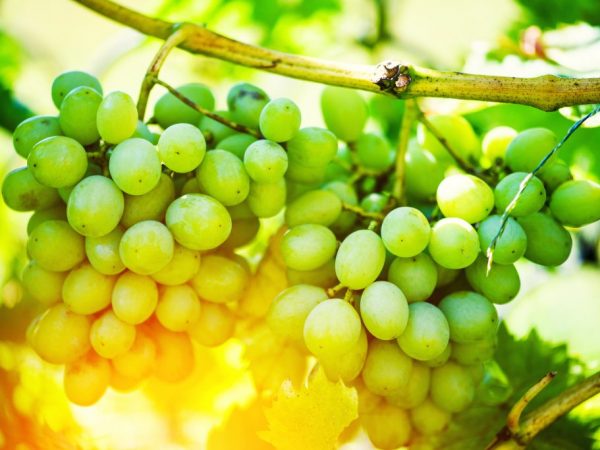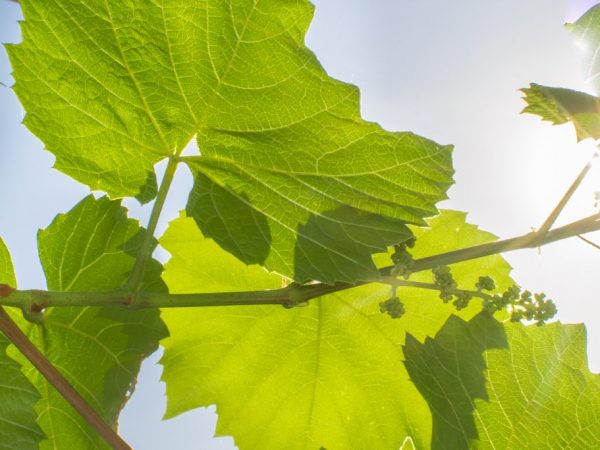Characteristics of the grape variety Phenomenon
The Phenomenon grape is a hybrid cultivar that resulted from the crossing of the species Villan Blin and Pleven. Refers to table types, because has a pleasant taste and appearance. Grown in the east and west of Europe.

Characteristics of the grape variety Phenomenon
Characteristics of grapes
The crop variety grown in different regions is slightly different in description. But there are some common features:
- the growth period is about 117 days;
- bunches do not wrinkle and do not crumble during transportation;
- have a high degree of rooting - up to 90%;
- harvest in mid-August.
Taste is not lost for about a month after harvest. It has a sweet and sour taste and a juicy berry, so juices and compotes are often made from it. Refers to white grape varieties that have a large amount of vitamins A, B, K, PP and trace elements.
Description of the bush and berries
According to the description, the vine Phenomenon is vigorous and tall. It reaches up to 10 m. The root is shallow. The leaves are rounded, dark green in color. have a strong odor, so they are not used as a treatment. The flower is bisexual, so no additional pollination is required.
Each bunch has about 40 large berries, white-green with a slight blush. 1 bunch reaches up to 1 kg. The flower is bisexual. The pulp is juicy, with bones. The skin is not thick, it can be easily removed. Ripe fruits have a beautiful yellowish or amber color.
Growing grapes
In the northern regions, the Phenomenon grapes, which are grown in the open field, are sheltered for the winter. Although the species is frost-resistant, it will not withstand below - 24 ° C.
It is planted in spring or autumn. When planted in the spring, the soil is watered abundantly. When choosing a site for planting, light and wind are taken into account. Culture loves the sun, but it can disappear in drafts.
When planting, plants adhere to several rules for growing and preparing:
- Distances between vine bushes Phenomenon 1.5 m, and between rows up to 3 m.
- A week before planting in open ground, the soil is loosened, a hole is dug up to 90 cm.
- Compost with soil is poured into the pits for a good harvest.
- Each seedling is tied to a holder until it is fully rooted.
A young bush in a pit is covered with a mixture of sand and earth. Before that, disinfecting the place with potassium permanganate. After planting the plant in open ground, it is watered abundantly, fertilized and left alone for 7 days.
Plant care

In the summer, you need to water the grapes every day.
Crop care consists of several agrotechnical measures: watering, pruning and feeding. Each year, an adult bush is cut into 9 eyes. Pruning is carried out only with a well-sharpened pruner and a processed tool. After harvesting, new shoots are cut.
Watering the plant depends on the weather. The soil should always be moist. After each watering, the soil is loosened so that a crust does not form. To retain moisture in the soil, it is mulched. Sawdust, dry grass and tree bark are suitable for mulch. In the summer, a young plant is watered every day. In August, watering is stopped.Watering is resumed in the autumn before the leaves fall.
Fertilizer
For feeding, both chemical fertilizers and organic matter are suitable. In the spring, nitrogen fertilizing is introduced. Diluted droppings are placed around the young vine for soil fertility.
For specimens from 4 years old, mix 1.5 buckets of droppings, 1 kg of ash and 4 liters of water. This mixture is infused for a week and diluted in 10 liters of water. Each bush needs 2 buckets.
For an adult plant, top dressing is also used, which includes:
- 30 g dry potash mixtures;
- 40 g superphosphate;
- 40 g nitrogen;
- 2 buckets of water.
Foliar dressing is carried out with a solution of superphosphate and nitrogen. Fertilize the bush before the first flowers appear. To do this, mix 30 g of superphosphate, 60 g of sugar and 40 g of nitrogen in 15 liters of water. Among the chemicals they choose:
- Florovit;
- "Biopon";
- Delan;
- "Shavit";
- "Master".
Of the minerals for the Phenomenon, potassium salt, ammonium nitrate and complex substances "Aquarin", "Solution" or "Rost-1" are used. Fertilizers of cultivation are combined with watering and preventive spraying against pests and diseases. Before opening the bushes after winter, they are also fertilized.
Diseases and pests
Fungal diseases:
- Milde. It manifests itself in the form of oil traces on the leaves. In different stages, the spots change color and turn red. The disease causes rotting and drying of shoots and leaves.
- White, black and gray rot. They appear in the form of a plaque on the berries, which eventually dry out, rot and fall off.
- Powdery mildew. A sign of oidium is a smoky white bloom on the shoots and cracked, deformed berries.
- Anthracnose. Dot disease that damages fruits, branches. Brown spots.
Untimely treatment of diseases will lead to the death of the entire plant and its root system.
Pests:
- phylloxera;
- spider or felt mite;
- leaflets;
- fragrant woodworm;
- marble beetle.
Insects damage crops. To combat them and diseases, chemicals and organics are used.
Disease and pest control
To get rid of most of the diseases, the bushes are sprayed with fungicides in the spring:
- "Topaz";
- "Speed";
- Tiovit;
- "Jet";
- "Bylet".
For prophylaxis use 15 g "Fundazol", 40 drops "Ecosil" and 2 ml "Topaz" in a bucket of water. Against black, white and gray rot, spraying with a solution is carried out, for which 20 g of benleit are mixed with 30 g of topsin. Also, against white and gray rot, the vine is treated with the preparations "Baylon", "Baytan" and "Atem S". Against mildi choose "Skor" and Bordeaux 2% solution.
The butterfly and caterpillars are destroyed by spraying with Decis, Proclame, Marshal or Insegar preparations. Against a spider mite, "Antiklesch", "Omite", "Sunmite", "Taurus" are suitable. All chemicals are diluted in water according to the instructions. When spraying, you should protect your eyes and skin with special glasses and a suit.
For prophylaxis, wood ash is poured onto the soil and leaves. To prevent disease and attack by pests, appropriate pruning, proper watering and fertilization are required.
Conclusion
The phenomenon does not require complex care. It is frost-hardy and grows in many regions. One of the most productive varieties with a pleasant taste. They are used both fresh and processed.

